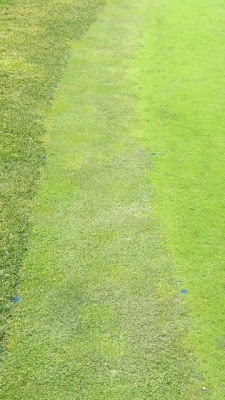Presented by the Golf Course Superintendents
Association of America
- A properly repaired ball mark heals completely in 2-3 days, while an unrepaired ball mark takes 15-20 days to heal properly.
- A typical 18-hole golf course covers approximately 125 - 150 acres of land. The total landmass of golf courses in the United States equals about 1/2 the state of Connecticut.
- A typical 18-hole golf course produces enough oxygen to support 4,000 to 7,000 people.
- Golf courses nationwide combine to filter 13 million tons of dust from the air every year.
- Who is the most important person at a golf facility? According to a 1997 survey of 500 Golf Digest subscribers, the golf course superintendent was listed the most (48 percent). Other responses included the course/club professional 25 percent, club/course manager 14 percent, beverage cart or halfway house person 11 percent.
- Golf courses have a cooling effect during the hot summer months. The average temperature on the golf course is typically 5- 7 degrees cooler than a residential area and 7 - 15 degrees cooler than an urban downtown setting.
- The infield of the Indianapolis Motor Speedway is home to four holes of the Brickyard Crossing golf course. The remaining 14 holes outside the oval are accessed through a tunnel under the track.
- Golf courses delay play on frost-covered turf (especially greens) because stepping on frost-covered grass causes the frozen leaf cells to rupture. The turf will turn brown and eventually die.
- The Old Works Golf Course in Anaconda, Mont., is the first golf course built on an Environmental Protection Agency Superfund Site. Designed by Jack Nicklaus, the land served as a smelting location for the mining of iron ore. The golf course opened in June of 1997.
- Why do golf course superintendents aerate turf? Because it reduces compaction on a golf course by removing soil cores from the ground, allowing the movement of water, air and nutrients to the turf roots. Highly traveled areas plus poor soil composition creates compacted surfaces.
- What is the origin of the stimpmeter? In the early 1900s, a man by the name of Edward Stimpson was looking for a means to create more fairness in the game of golf. Specifically, he was looking to make putting surfaces on a particular course all relatively the same speed. He developed the stimpmeter to achieve this purpose. By using this device, he could determine, for example, if the fourth green was the same speed of the 17th. The device is often misused and misinterpreted by the novice and avid golfer alike. It is best used to compare greens on the same course, NOT to compare greens from one course to another.
- How much has technology and research improved speed and quality of a putting green? In the early 1960s, professional tour event superintendents cut putting green turf heights at about 1/4 inch. Today, the height of putting green turf for professional tournament competition is 1/8 inch or less.
- How do trees affect the quality of a putting surface? All things being equal, a putting green with air circulating around it will be in better shape than a green with little or no air circulation. Trees tend to reduce circulation, thereby having a negative effect on putting green quality. Older, more mature trees adjacent to putting greens will negatively impact surface conditions because the tree roots will grow under the putting surface and disrupt the flow of water and nutrients.
- What is a golf course superintendent doing when he/she syringes a green? Syringing is the process of spraying a light cover of water on a green during hot weather to reduce the temperature of the turf. This prevents putting surfaces from becoming “baked” or “dried-out,” and having a negative impact on putting surface quality.
- What is topdressing? It is the practice of spreading material over a putting green to level and smooth the surface. The material is generally sand and/or organic matter that improves drainage, controls thatch and maintains biological balance.
- Golf courses have a positive impact on the economy. It is estimated that more than 25 million people annually spend 2.5 billion hours outside, playing one of the nation’s 17,000-plus golf courses. The impact of golf facilities on the economy is $20 billion annually.





































